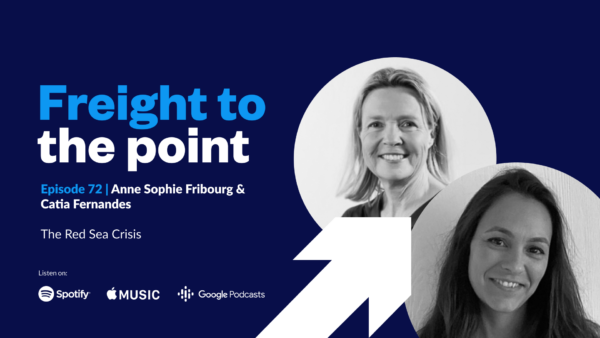Episode 35:
Zencargo’s January Ocean Update
See all episodes

“Chinese New Year is earlier this year, and everyone is looking to really understand whether or not there’s going to be a rush on cargo in advance. The news so far is that volumes continue to be at low levels.”
Tune into our first episode of 2023 as we’re giving a January Ocean Update with Marina Lennie and Richard Fattal.
This month, we’re covering insights on:
- How an early Chinese New Year has affected shippers
- What we’re seeing in the rate market
- Whether the changes in China’s zero-Covid policy will affect supply chains
Marina Lennie
Marina Lennie is the Director of Ocean Growth at Zencargo. Marina has over 20 years experience in the shipping space, having worked at MSC for over 10 years. She now leads the pricing team at Zencargo, and is responsible for the company’s pricing processes and strategy.
Richard Fattal
Richard Fattal is Co-Founder and Chief Commercial Officer of Zencargo, the digital freight forwarder enabling organisations to make smarter decisions through real-time data of their supply chain. Based in London, Zencargo helps customers manage their supply chain such as Swoon Furniture and Ribble Cycles.
Resources
 |
Hi, and welcome to another episode of Freight to the Point. I’m Marina Lennie, Zencargo’s director of Ocean Growth. And today we’ve invited Richard Fattal back on again to talk about what’s happened in the ocean market in the past month, and what we need to look out for, especially as we’re headed towards Chinese New Year. Richard works very closely with the customers at Zencargo to get the best rates and transit times, as well as providing bespoke rate consultations. Hi, Richard. Welcome back. |
|
Hi, Marina. Thanks so much for having me on, and Happy New Year.
|
 |
 |
And to you, and to you, and all this exciting rate and shipping news to follow. In the last ocean episode, we talked about levels of port congestion both in Europe and in The U.S. having gone back to near pre-COVID levels, and how the IMO regulations were affecting carrier behaviours. We also looked into Black Friday, and data showing the fall in demand isn’t as bad as we previously anticipated. So I thought this time, we could talk a bit about what the things are that have happened in the last month, and what you saw affect the market. |
|
Yeah, 100%. So I think the reality is, it’s certainly more of the same from a demand perspective. Chinese New Year is earlier this year, and everyone is looking to really understand whether or not there’s going to be a rush on cargo in advance, a factory shutting down in China for the normal break. The news so far is that volumes continue to be at low levels. CNBC reported manufacturing orders had fallen by 40%, and the Chinese manufacturers purchasing index registered 48 in November, which is the lowest reading for some time. And with the Chinese factories getting ready to close up shop for what is effectively quite an early Chinese New Year this time, and with factories planning to close a couple of weeks ahead of Chinese New Year, really looks like there isn’t going to be that level of rush on cargo that people were maybe thinking might come, let’s say a couple of weeks back.
The reality is that what we’re seeing is very much more of the same container trade statistic numbers from a U.S. reporting perspective continue to be low, and we’ve continued to see broadly broad-based 20% reduction in cargo arriving in The U.S. I think the one thing that is, let’s say new since we last spoke, is that the rate and the extent of vessel capacity reductions that we see ahead, and also potentially post-Chinese New Year. Vessel capacity is being reduced by anywhere between 40 to 50%, particularly on the Ocean Alliance and the Alliance, and 2M of Maersk and MSC has suspended almost half of their U.S. West Coast services in December. So both on the Asia-Europe lane, and on the Trans-Pacific, there are broad-based reductions in services.
So what that means is, booking space is broadly less challenging, getting space on a service is a completely different picture, let’s say to earlier in 2022, but getting space on the right service, or the service that gets you into your warehouse, into your destination market when you expect it, or getting capacity on the alliance, or the loop that you had anticipated might be more challenging, because a sailing might be out of service, or a port might be emitted. And so, actually, agility again becomes a really important ingredient in your supply chain arsenal when managing through this period. So I would say, there’s more of the same in terms of demand reduction, but there is a more notable reaction of the carriers to take out capacity, and that brings up the question of what will happen to the rate picture and what will happen going forward.
|
 |
 |
So if you consider that demand has actually not decreases dramatically as we thought, but yet slightly lower numbers, but then on the capacity side, you’re saying up to half of vessel capacity has been removed, I do wonder, and we’ll talk about that later, on what sort of effect that has on rates, and what your suggestion is for customers to be able to navigate that period, where there’s still less unknown on the operational side because we know about the blank sailings, and we then know that there’s less congestion, but more on the front of how we should act knowing the parts that we do know of the puzzle. So those were quite a few findings that were… And insights from December, and now we know Chinese New Year, et cetera. What are the latest insights on the ocean market that are coming for the next month, and what do you think that people can look out for, or what’s likely to happen as we head into Chinese New Year? |
|
Well, with the capacity coming out of the market, we’re definitely seeing some stabilisation of the short-term rate market, both on the Trans-Pacific and on the Asia-Europe lane. So rates have, since the beginning of December, I would say stopped declining at the same rate, they’ve now stopped declining I would say altogether. There have been some attempts by some carriers to put up rates, for the moment, they don’t seem to be very substantial, and broadly rate levels are stabilising, and the question will be, on balance, what do we see happen, let’s say in the first couple of weeks of January? I think it’s quite a diverse picture for the moment, so some carriers have held, some carriers have made small increases, often as the market stabilises, you have different players in the market put rate rises out into the market, and then you learn quickly whether or not the demand picture supports a rise in the rates or not.
So I would say, it’s a very much a watch this space over the next week to two weeks. But I would say that given the environment that we’ve seen play out over the last week or two, the ability of the carriers to show that they can manage capacity, change the way that services work, that actually, now is a good time to start to think about, whilst the spot market has been very attractive, now is a good time to start to think about what the right strategy is for you as a shipper.
And so that might, as maybe we’ll go on to discuss, very much depend on the nature of your volumes, the stability of your volumes, and the pattern of your volumes through the year, and also the extent to which you need certainty and assurity around a service, so that if you can’t get onto one service you can get onto another. But I think it very much becomes interesting to start to think about locking in some stability, especially given that we’re operating at much lower levels than last year from a budgeting perspective. So that’s a conversation that I think we’ve already started to have with many customers in December, and I think we’ll only continue into the new year.
|
 |
 |
And so just for our listeners, and maybe just around your point on rates and diversifying, perhaps what people are looking for, and like we said, there’s less congestion, so maybe service is improving, but then I hear you saying that capacity is being removed, and therefore, that always has an impact on the quality of service, and the level of service that carriers are able to give, because if you’re changing services, removing capacity, et cetera, there’s likely to be some impact there. So moving forward, would a diversified strategy benefit them? And if so, how? And how are they able to look into those things in more depth? |
|
Yeah, certainly. So I think there’s a few things to consider. So one parameter is around space protection and stability of service. And if you operate solely in the FAK market, the advantage that you have is that you can benefit from an array of options. In some cases, the rates in the market might be slightly cheaper than what’s on a longer term agreement, depending on the particular month as an example. But the disadvantage is that you don’t necessarily benefit from space protection from the carrier. And whilst there might be some concerns around a particular carrier blanking on one loop, most of the carriers are a part of an alliance, and so what tends to happen is, if you have a space protection relationship with a carrier, you can either go move your cargo on their, let’s say, own operated service, or you can move it on the service of one of their partners.
And so long as you have space protection, and a more stable relationship and agreement, you get what they call load list priorities. So you get priority in the ranking when it comes to look at which cargo they’re going to move from the port when there is more cargo than the available capacity. And these situations of more cargo in the available capacity happen when a particular service gets blanked, or when a port gets emitted at the last minute and you get rolled over to another vessel. So if your transit time is important to you, you’ve got particularly sensitive goods, it starts to become interesting to say, “Okay, how can I achieve space protection on at least, for example, a percentage of your cargo?” So a diversified strategy to procurement might mean that on a percentage, or for some customers, all of their cargo, they want to get some measure of space protection, and therefore, potentially enter into a longer term contract.
The other parameter is around price, and the question might be, look, now, on balance, given the fall in the market, there might still be some risk to the downside on pricing, because, for example, after Chinese New Year, there could be a deficit of cargo, factory slow to ramp back up, but broadly, there will be a restocking in 2023. At a certain point, businesses will have depleted through stocks, and they’ll be restocking. And the general consensus on global recession, a reduction in demand for next year, is a sort of single digit decline in demand. The much bigger impact that we’re seeing now in terms of cargo flow is the fact that businesses have been de-stocking for a period of months, just not shipping at all. So given that we know that there will be restocking, it becomes a question of, is now a good time to lock in some of my capacity at a fixed rate? Even if I don’t get the best rate in the market, does it make sense to de-risk the chance that the market goes up, especially given how high it’s been?
So I think it’s both of those parameters around space protection, and around rate, that makes it interesting to start to consider a diversified strategy that might still consider some spot space, also because of the blank sailing, some ability to be more versatile and move across carriers, but that might look at locking in an agreement on some of the volumes. And I think whilst maybe the last few months it’s made much more sense to ride the market, the softer market down, and to be on the spot market, it now makes sense to look at how you can have a longer term relationship. And particularly because if the market does change in dynamic, that support that you’ll have given working with a partner should help you to be supported in that more difficult market environment.
|
 |
 |
So what I’m hearing you saying is, there needs to be somewhat of a more strategic approach to the rates where we have a more diversified approach, and certain volumes of cargo can be dedicated to different forms of stability, service, rate, et cetera, so based on whatever the customer needs for those particular shipments. And so around that, how is the shipper able to best prepare for that particular strategy, i.e. what tools are available to him to be able to nail that. |
|
Yeah, 100%. So I think everyone out there will have just gone through an annual budgeting process, and if you haven’t, you’ll be furiously hitting shift F9 on your spreadsheets trying to make all these formulas work, and report up to your boss about what, what’s going to happen in 2023. And part of that is your sales forecast, part of that is what you think is going to be sold, whether it’s in stores, online, to your business-to-business customers. But part of that is also understanding your supply chain volumes and what you’ve ordered from your factories, and what that means for the capacity that you need during the year, and the seasonality of that demand. And it always helps to have a good forecast, and to understand your forecast also at the level of, “What is stock that I’m always going to order? What is stock that has limited seasonality, it’s unlikely to change, and I really believe in this forecast? And what is stock that maybe has more risk around it?”
And I think if you have a forecast that you have some faith in, you can work very closely with your freight partner, with your freight forwarder, with the carriers, and you can work out, really, what makes the most sense for you, and where you have assurity of a certain amount of volume that’s going to move month in, month out. I think that’s where it becomes interesting, to use that assurity to lock in an agreement, to lock in a relationship to get some advantage when it comes to space protection, et cetera, and where you’ve got peaks and troughs, then there might be an opportunity to be a bit more agile with that capacity.
That’s really very much the approach that we’re adopting with our customers. I think the other thing that you can do is to think about contingencies for different scenarios, like what would you do if you needed more capacity, or, for example, if you didn’t have as much volume as you were planning, or if, for whatever reason, the supply chain became disrupted again, because we’ve seen our fair share of mega disruptions to the supply chain over the last couple of years. And the big watch-out that I think we’d be amiss if we didn’t talk about on this podcast is what’s going on in China with COVID, and the changes in the lockdown rules.
And that’s led, of course, to a real surge in cases in China that we’re starting to see now. And on our daily call with our teams out there, unfortunately, there are a lot of people who are catching COVID, for the most part, in my experience so far, symptoms have been mild, although there is, of course, a higher proportion of elderly unvaccinated in China, and so it is a significant risk factor. Our base case at Zencargo for the moment is that whilst we do think that Chinese New Year will mean a large surge in cases, people are moving around, it’s one of the largest movements of people anywhere in the world every year, the Chinese New Year holiday, we don’t think it will create global supply chain disruption. So there could be reduction in available factory capacity workers who are sick, but we are operating in an environment where the demand picture is weak, and factories are looking for work. And so we think to some extent there’ll be some offsetting effects there.
And on top of that, we don’t anticipate any significant surge in demand like we saw last time out of the end markets. So it’s really very much a different story to the last time around, but I wouldn’t want to say that one should be blind to what’s going on, and I think we need to monitor the situation extremely carefully. And of course, if you’re ordering from China, you’ll be in touch with your factories, you’ll understand their picture, and of course, you need to understand your own demand picture, and when you are looking to restock. But I would say, that’s one of the big watch-outs in the new year, but for the moment, our base case is, 2023 should be an easier year than 2022, and we don’t see that the change in Chinese COVID policy… It should not likely create significant global supply chain disruption.
|
 |
 |
Okay, so some caution in being optimistic, I think would be the general takeaway that I’d get from that. So remaining agile, both on the rate front, drill into those forecasts to make sure you can leverage as much value from them, both in terms of partnerships with your forwarder, and then with your carrier. Lookout for service levels, and yes, watch this space, I would say. So thanks again, Richard, so much for being with us.
|
|
Thank you so much, Marina.
|
 |
 |
Thanks again to our listeners for tuning in to this episode of Freight to the Point, and don’t forget to like and subscribe to our show. If you have any feedback on this episode, please don’t hesitate to reach out on LinkedIn. And until next time, goodbye. |

Episode 72: The Red Sea Crisis
In the latest episode of Freight to the Point, we’ve featured our most rec...

Episode 71: The potential of demand forecasting with artificial intelligence
In the most recent instalment of Freight to the Point, Lucie Phillips, Zen...

Episode 70: Rates: What's next for 2024?
As we prepare for the year ahead, it's crucial to consider the three pillars...

